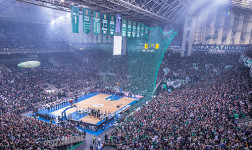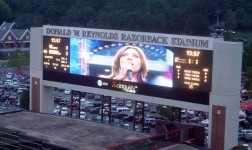PART I – HISTORICAL ATTENDANCE
First, let’s set a baseline by reviewing attendance for the past 11 FBS seasons (source NCAA attendance records). During that period, non-bowl home attendance in the aggregate is up ~ 500,000 fans to 5.3 million, an increase over 10% from 2000 to 2010. 80 programs have more attendance (average increase of 27% / +7,500 total additional fans) and 40 programs have less attendance (average decrease of -12% / -4,500 total fewer fans). Only 24 programs have increased attendance by more than 10,000 fans since the 2000 season (+ ~ 1,000 new fans / season), and the Big East has seen the biggest gains, with six of their teams increasing attendance over 10,000 fans in the last 11 years. The ACC has been hardest hit in the last decade plus, with four of their teams losing over 5,000 fans each.
PART II – RECENT ATTENDANCE
Second, let’s focus on the recent past. Over the past four FBS seasons (2006-2010), only four programs in FBS experienced an increase attendance every single season: Cincinnati (up 72% / 14,694 total additional fans); East Carolina (up 34% / 12,497 total additional fans); Miami, FL (up 25% / 10,667 total additional fans); and Utah St (up 57% / 6,518 total additional fans). In fact, company remains select among programs for increased attendance every year of the last three since 2007: TCU (up 35% / 10,540 total additional fans); Boise State (up 9% / 2,816 total additional fans); and Mississippi (up 4% / 2,097 total additional fans). Although attendance for Kent State and Arizona was up all three seasons 2007- 2010, those gains have not returned overall attendance performance to their 2006 season levels. While TCU and Boise State may appear more obvious, the others may represent opportunities to study.
While it is intuitive to correlate these attendance increases with improved teams and higher winning percentages, we did not find that relationship in the data. Moreover, the data does not indicate that a particular head coach’s hire or performance had any bearing on attendance numbers. As we’ll discuss further in a moment, it takes a few up or down seasons to move attendance significantly. So clearly, to the extent attendance levels “return to the mean” over time for a given program, or trend downward, non ticket sales revenue streams become more important to overall football revenue.
PART III – CORRELATIONS IN ATTENDANCE PERFORMANCE
Third, let’s consider other factors that correlate (i.e., potential cause agents) to positive and negative FBS attendance performance.
1. Sustained winning is important. The driving force behind big ticket sales is generally a compelling and successful team. Between 2008 and 2010 the average NCAA stadium was filled to 79.95% capacity – about 44,000 fans. However, teams that had winning seasons in that same time period drew crowds of around 53,000 (88.19%) – an 8% jump in attendance.
Teams that were coming off winning seasons – regardless of whether or not they maintained their winning ways – actually sold more tickets (89.03% of capacity) than their winning predecessors. This same difference is carried on, and exacerbated, to the upper echelons of success – teams with 90% or better winning percentages. It’s very hard to win 90% of your games, and fan bases reward that with home games for those teams averaging almost 63,000 fans (97.38%). But the reward is even greater the following season. Despite seeing their winning percentages (W%) drop, on average, to a more reasonable 73%, teams coming off huge years actually sold more tickets than they did in the middle of their success, coming extremely close – 99.98% – to selling out across the board.
Not surprisingly, losing has a similar effect on fan support. Teams that dropped below .500 played in front of crowds that weren’t even ¾ full, with an average stadium being filled to 70.5% capacity. The negative publicity that comes with losing continued to hurt teams the next year. Despite averaging Wpct hikes of 8%, teams coming off a losing season saw their attendance numbers drop to 69.7%. The lesson here is twofold: 1. winning helps as much as losing hurts; and 2. it usually takes a year for positive results on the field to be reflected with positive results in the stands.
| Teams that have performed below .500 and maintained good attendance between 2008 – 2010: | ||||
|---|---|---|---|---|
| COLORADO | BIG-12 | 36.1 WPCT | 0 weeks in TOP-25 | 92.7% CAP |
| KANSAS STATE | BIG-12 | 48.5 WPCT | 0 weeks in TOP-25 | 94.5% CAP |
| MICHIGAN | BIG TEN | 40.2 WPCT | 0 Top-5 CONF. FINISHES | 102.2% CAP |
2. AQ conference schools draw substantially better. The typical (i.e., average) AQ conference school has 25,533 undergrads, one pro sports team in the area, wins 57% of its games and has a ratio of 55 regular citizens to every student in vicinity of campus. The average non-AQ conference school has 20,462 students, one pro sports team in the area, wins 46% of their games and has 59 regular citizens for every student. While those baselines are similar, the difference is reflected in attendance: the average AQ school attracts 61,000 fans to each home game, while the average non-AQ schools attracts 24,000 fans to each home game. Although AQ schools having bigger stadiums (the same disparity exists as a percentage of capacity: 92% to 66%) and stronger on field performance (11% difference in Wpct is significant but not that significant), the most likely reason for the disparity is the tradition of AQ schools and their opponents.
| Small schools that have avoided this problem between 2008 – 2010: | ||||
|---|---|---|---|---|
| BOISE STATE | WAC | 94.9 WPCT | 19,993 students (28 ratio) | 102.4% CAP |
| NAVY | Independent | 67.4 WPCT | 4,400 students (115.8 ratio) | 97.2% CAP |
| OREGON | PAC 10 | 81.9 WPCT | 16,475 students (20.5 ratio) | 108.9% CAP |
3. Large city population and the presence of pro teams hurt attendance. As much as a big school helps attendance, a big city hurts attendance. Medium sized college towns (100,000-500,000) filled their stadiums to 83.7% of capacity (50,000 per game). The same success was shown in larger college towns (500,000-1 million) with 83% attendance (44,000) and small college towns (less than 100,000) 80% (33,000). All this despite sporting average football teams (all hovering around .500). Colleges in cities (1 to 4 million people) attracted less than 40,000 fans to their games, only 75% attendance – below the NCAA average. The performance was worse in the biggest of cities (4 million+) whose colleges outperformed their competitors on the field – 58% W% – but similarly only drew 40,000 fans (70% of capacity). One factor is the presence of other outlets for sports fans in these cities – i.e. Big Four sports teams. Colleges who did not have to compete with Big Four teams filled their stadiums to 83% of capacity, regardless of winning percentage. Teams that did? Just 74%. That’s a 9% difference, equivalent to 30,000 fewer tickets being sold per year by schools with pro teams in the area.
| Schools with pro teams in the area that have avoided this problem between 2008 – 2010: | ||||
|---|---|---|---|---|
| SOUTH FLORIDA | BIG EAST | 61.5 W% | Tampa, FL (3 Pro Teams) | 1003.3% CAP |
| CINCINNATI | BIG EAST | 68.1 W% | Cincinnati, OH (2) | 96.2% CAP |
| UTAH | MTN WEST | 84.6 W% | Salt Lake City, UT (1) | 100.8% CAP |
4. Private schools have a harder time drawing. Even though private schools, on average, have slightly better football teams than public schools (a W% difference of +1%), public schools draw 5,000 more fans on average per game (80.5% vs. 76.5% capacity). There are three primary explanations for this:
A) Private schools draw from a national pool of students. Therefore, there are fewer instate allegiances passed on from generation to generation.
B) Private schools are smaller than public schools: Average of 25,259 undergrads at public schools compared to 10,791 at private schools. This means there is less value in undergraduate support and there is a smaller alumni base of fans.
C) Private schools are generally located in bigger cities, closer to more pro sports teams. The average private school is in a metropolitan area in excess of three million citizens with just over two pro sports teams. For public schools, on average, there is less than one sports team and just over one million people.
PART IV – NON-CONFERENCE SCHEDULING
Finally, let’s examine opportunities for increasing ticket sales through the scheduling of nonconference opponents. AQ conference teams draw significantly better at home than non- AQ schools. This is also true on the road. Between 2006 and 2010, AQ teams that took to the road for non-conference games filled stadiums to 90.83% of capacity, compared to just 83.9% for non-AQ schools. Notice that both of these numbers are significantly higher than the NCAA Average for that time period (79.95%). For whatever reason, fans show up for non-conference games in greater numbers than for in-conference games. Also of note, though it might hurt your strength of schedule, hosting FCS schools only drops the average attendance to 78.71%, only slightly more than a 1% difference compared to the NCAA average. Here are four specific observations on non-conference scheduling.
1. AQ schools are less likely to travel. Since 2006, only 379 non-conference games have been played in which a team from a AQ conference was on the road. To put that in perspective, non-AQ schools played 650 road non-conference games and FCS (Division 1-AA) schools played 426. Of those 379 games, only 145 were at non-AQ schools. That means that out of the 1,074 non-conference games involving AQ teams only 13.5% did not have a AQ conference host. When these AQ teams played at non-AQ venues they saw crowds filled to 85.3% of capacity, an almost 20% increase over the mean for non- AQ schools (on average that’s 10,000 tickets per game). AQs @ AQs achieved 94.5% of capacity, an increase of 3% over average AQ-conference ticket sales.
AQ schools perform well on the road as well. Teams hosting AQ-conference schools only won 48% of their games. That number drops to 34% when there’s a non-AQ host. From a cost-benefit analysis perspective (assuming a AQ-conference team will travel to your school) the value of the increased attendance has to be weighed against the high probability of defeat. That said, a victory over a high profile can do wonders for a program’s visibility.
2. Non-AQ schools have a rough time on the road. Home teams hosting non-AQ schools in non-conference games won 77% of their games. Despite dropping to a more reasonable 55% when a non-AQ school hosts a non-AQ school that is still a relatively high winning percentage. Coupled with 83.9% attendance (71.8% for non-AQs @ non-AQs) you’re not sacrificing much in the way of potential home defeat and not receiving as large of a reward in ticket sales if you choose to attempt to schedule non-AQ schools for your nonconference games.
3. For FCS schools, it is preferable to maintain proximity.The conventional wisdom behind hosting a FCS for one of your non-Conference games is that it’s – hopefully – an easy win, and it can help serve as a tune-up for the rest of the season. To a large extent this is true. Since 2006, teams hosting FCS schools have won 92.5% of those matchups, and those teams that hosted have had an average winning percentage of 54%; meaning, the difference between an early season win over a FCS school and a loss in a more competitive non-conference game can be a bowl appearance. People also assume that scheduling FCS schools will result in low attendance (as we showed above) but this doesn’t necessarily have to be true. The average NCAA game fills the stadium to around 80% of capacity. Since 2006, more than half (54%) of games in which teams hosted FCS schools have achieved that number and more. Part of this is that these are usually the first games of the season (88% coming before week five), and with a fresh season comes enthusiasm from the fan base. But another important factor is careful selection of which FCS schools to invite.
Of the 64 games that sold out between FBS hosts and FCS opponents, the vast majority involved in-state, or bordering state, FCS opponents. This isn’t only true for powerhouses like Ohio State and Oregon hosting Youngstown State (102.65%) and Portland State (108.28%) respectively, but also non-AQ schools like Louisiana-Lafayette hosting in-state rivals McNeese State (133.41%) and Southern University (109.12%) – La-Lafayette’s average attendance over this time span was 61.8% – or SMU hosting Stephen F. Austin (108.59%) – SMU averaged 66.1% attendance. Getting the community interested in nonconference games is a great way to increase ticket sales.
4. Cost-Benefit relationship for non-conference games (each case is different, but these averages provide a reasonable base line):
| For AQ-conference schools: | ||||
|---|---|---|---|---|
| Host AQs | 94.5% capacity (+3.01%) | 48.0 Wpct (-8.69%) | ||
| Host Non-AQs | 89.6% capacity (-2.03%) | 87.8 Wpct (+31.1%) | ||
| Host FCS | 86.7% capacity (-4.9%) | 94.5 Wpct (+37.8%) | ||
| For Non-AQ-conference schools: | ||||
|---|---|---|---|---|
| Host AQs | 85.3% capacity (+19.4%) | 34.4 Wpct (-11.4%) | ||
| Host Non-AQs | 71.8% capacity (+5.9%) | 55.0 Wpct (+9.2%) | ||
| Host FCS | 66.9% capacity (+1.0%) | 89.5 Wpct (+43.7%) | ||
Our school by school analysis showed the highest impact on ticket sales for a non-conference game is +15% (Boise State and Texas), followed by another 19 schools who represent at least a +5% to 10% increase in ticket sales. Those teams may represent a premium in the game fee due to increased attendance, while others at the opposite end of the spectrum may represent a discounted game fee because of decreased attendance. There’s one place you’ll find comprehensive pricing information for those matchups: Win AD.




